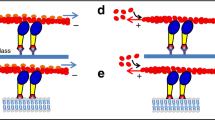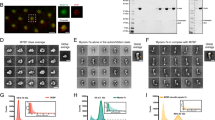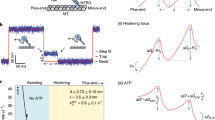Abstract
It has long been known that microtubule depletion causes axons to retract in a microfilament-dependent manner, although it was not known whether these effects are the result of motor-generated forces on these cytoskeletal elements. Here we show that inhibition of the motor activity of cytoplasmic dynein causes the axon to retract in the presence of microtubules. This response is obliterated if microfilaments are depleted or if myosin motors are inhibited. We conclude that axonal retraction results from myosin-mediated forces on the microfilament array, and that these forces are counterbalanced or attenuated by dynein-mediated forces between the microfilament and microtubule arrays.
This is a preview of subscription content, access via your institution
Access options
Subscribe to this journal
Receive 12 print issues and online access
$209.00 per year
only $17.42 per issue
Buy this article
- Purchase on Springer Link
- Instant access to full article PDF
Prices may be subject to local taxes which are calculated during checkout




Similar content being viewed by others
References
Halloran, M. C. & Kalil, K. Dynamic behaviors of growth cones extending in the corpus callosum of living cortical brain slices observed with video microscopy. J. Neurosci. 14, 2161–2177 (1994).
Tanaka, E. & Sabry, J. Making the connection: cytoskeletal rearrangements during growth cone guidance. Cell 83, 171–176 (1995).
Yamada, K. M., Spooner, B. S. & Wessells, N. K. Ultrastructure and function of growth cones and axons of cultured nerve cells. J. Cell Biol. 49, 614–635 (1971).
Bray, D. & Bunge, M. B. Serial analysis of microtubules in cultured rat sensory axons. J. Neurocytol. 10, 589–605 (1981).
Yu, W. & Baas, P. W. Changes in microtubule number and length during axon differentiation. J. Neurosci. 14, 2818–2829 (1994).
Letourneau, P. C. Differences in the organization of actin in growth cones compared with the neurites of cultured neurons from chick embryos. J. Cell Biol. 97, 963–973 (1993).
Fath, K. R. & Lasek, R. J. Two classes of actin microfilaments are associated with the inner cytoskeleton of axons. J. Cell Biol. 107, 613–621 (1988).
Lewis, A. K. & Bridgman, P. C. Nerve growth cone lamellipodia contain two populations of actin filaments that differ in organization and polarity. J. Cell Biol. 119, 1219–1243 (1992).
Bearer, E. L. & Reese, T. S. Association of actin filaments with axonal microtubule tracts. J. Neurocytol. 2, 85–98 (1999).
Yamada, K. M., Spooner, B. S. & Wessells, N. K. Axon growth: role of microfilaments and microtubules. Proc. Natl Acad. Sci. USA 66, 1206–1212 (1970).
Letourneau, P. C., Shattuck, T. A. & Ressler, A. H. ‘Pull’ and ‘push’ in neurite elongation: observations on the effects of different concentrations of cytochalasin B and taxol. Cell Motil. Cytoskeleton 8, 193–209 (1987).
Forscher, P. & Smith, S. J. Actions of cytochalasins on the organization of actin filaments and microtubules in the neuronal growth cone. J. Cell Biol. 107, 1505–1516 (1988).
Lin, C. H. & Forscher, P. Cytoskeletal remodeling during growth cone-target interactions. J. Cell Biol. 121, 1369–1383 (1993).
Challacombe, J. F., Snow, D. M. & Letourneau, P. C. Actin filament bundles are required for microtubule reorientation during growth cone turning to avoid an inhibitory guidance cue. J. Cell Sci. 109, 2031–2040 (1996).
Rochlin, W. M., Dailey, M. E. & Bridgman, P. C. Polymerizing microtubules activate site-directed F-actin assembly in nerve growth cones. Mol. Biol. Cell 10, 2309–2327 (1999).
Solomon, F. & Magendantz, M. Cytochalasin separates microtubule disassembly from loss of asymmetric morphology. J. Cell Biol. 89, 157–161 (1988).
Joshi, H. C., Chu, D., Buxbaum, R. E. & Heidemann, S. R. Tension and compression in the cytoskeleton of PC12 neurites. J. Cell Biol. 101, 697–705 (1985).
Heidemann, S. R. & Buxbaum, R. E. Tension as a regulator and integrator of axonal growth. Cell Motil. Cytoskeleton 17, 6–10 (1990).
Walczak, C. E. & Mitchison, T. J. Kinesin-related proteins at mitotic spindle poles: function and regulation. Cell 85, 943–946 (1996).
Walczak, C. E., Vernos, I., Mitchison, T. J., Karsenti, E. & Heald, R. A model for the proposed roles of different microtubule-based motor proteins in establishing spindle bipolarity. Curr. Biol. 8, 903–913 (1998).
Koonce, M. P. et al. Dynein motor regulation stabilizes interphase microtubule arrays and determines centrosome position. EMBO J. 18, 6786–6792 (1999).
Ma, S., Trivinos-Lagos, L., Graf, R. & Chisholm, R. L. Dynein intermediate chain mediated dynein-dynactin interaction is required for interphase microtubule organization and centrosome replication and separation in Dictyostelium. J. Cell Biol. 147, 1261–1273 (1999).
Garces, J. A., Clark, I. B., Meyer, D. I. & Vallee, R. B. Interaction of the p62 subunit of dynactin with Arp1 and the cortical actin cytoskeleton. Curr. Biol. 9, 1497–1500 (1999).
Gonczy, P., Pichler, S., Kirkham, M. & Hyman, A. A. Cytoplasmic dynein is required for distinct aspects of MTOC positioning, including centrosome separation, in one cell stage of Caenorhabditis elegans embryo. J. Cell Biol. 147, 135–150 (1999).
Busson, S., Dujardin, D., Moreau, A., Dompierre, J. & Mey, J. R. D. Dynein and dynactin are localized to astral microtubules and at cortical sites in mitotic epithelial cells. Curr. Biol. 8, 541–544 (1998).
Carminati, J. L. & Stearns, T. Microtubules orient the mitotic spindle in yeast through dynein-dependent interactions with the cell cortex. J. Cell Biol. 138, 629–641 (1997).
Inoue, S., Yoder, O. C., Turgeon, B. G. & Aist, J. R. A cytoplasmic dynein required for mitotic aster formation in vivo. J. Cell Sci. 111, 2607–2614 (1998).
Ahmad, F. J., Echeverri, C. J., Vallee, R. B. & Baas, P. W. Cytoplasmic dynein and dynactin are required for the transport of microtubules into the axon. J. Cell Biol. 140, 246–256 (1998).
Evans, L. L. & Bridgman, P. C. Particles move along actin filament bundles in nerve growth cones. Proc. Natl Acad. Sci. USA 92, 10954–10958 (1995).
Karki, S. & Holzbaur, E. L. Cytoplasmic dynein and dynactin in cell division and intracellular transport. Curr. Opin. Cell Biol. 11, 45–53 (1999).
Shaw, G. & Bray, D. Movement and extension of isolated growth cones. Exp. Cell Res. 104, 55–62 (1977).
Baas, P. W. & Heidemann, S. R. Microtubule reassembly from nucleating fragments during the regrowth of amputated neurites. J. Cell Biol. 103, 917–927 (1986).
Yu, W. & Baas, P. W. The growth of the axon is not dependent upon net microtubule assembly at its distal tip. J. Neurosci. 15, 6827–6833 (1995).
Spector, I., Sochet, N. R., Kashman, Y. & Groweiss, A. Latrunculins: novel marine toxins that disrupt microfilament organization in cultured cells. Science 241, 493–495 (1983).
George, E. B., Schneider, B. F., Lasek, R. J. & Katz, M. J. Axonal shortening and the mechanisms of axonal motility. Cell Motil. Cytoskeleton 9, 48–59 (1988).
Lin, C. H., Espreafico, E. M., Mooseker, M. S. & Forscher, P. Myosin drives retrograde F-actin flow in neuronal growth cones. Neuron 16, 769–782 (1996).
Meeusen, R. L. & Cande, W. Z. N-Ethylmaleimide-modified heavy meromyosin: a probe for actomyosin interactions. J. Cell Biol. 82, 57–65 (1979).
Meeusen, R. L., Bennett, J. & Cande, W. Z. Effect of microinjected N-ethylmaleimide-modified heavy meromyosin on cell division in amphibian eggs. J. Cell Biol. 86, 858–865 (1980).
Echeverri, C. J., Paschal, B. M., Vaughan, K. T. & Vallee, R. B. Molecular characterization of the 50-kD subunit of dynactin reveals function for the complex in chromosome alignment and spindle organization during mitosis. J. Cell Biol. 132, 617–633 (1996).
Wittmann, T. & Hyman, T. Recombinant p50/dynamitin as a tool to examine the role of dynactin in intracellular processes. Methods Cell Biol. 61, 137–143 (1999).
Heidemann, S. R., Kaech, S., Buxbaum, R. E. & Matus, A. Direct observations of the mechanical behaviors of the cytoskeleton in living fibroblasts. J. Cell Biol. 145, 109–122 (1999).
Ingber, D. E. Tensegrity: the architectural basis of cellular mechanotransduction. Annu. Rev. Physiol. 59, 575–599 (1997).
Kolodney, M. S. & Elson, E. L. Contraction due to microtubule disruption is associated with increased phosphorylation of myosin regulatory light chain. Proc. Natl Acad. Sci. USA 92, 10252–10256 (1995).
Hirose, M. et al. Molecular dissection of the Rho-associated protein kinase (p160ROCK)-regulated neurite remodeling in neuroblastoma N1E-115 cells. J. Cell Biol. 141, 1625–1636 (1998).
Olsson, P-R., Korhonen, L., Mercer, E. A. & Lindholm, D. MIR is a novel ERM-like protein that interacts with myosin regulatory light chain and inhibits neurite outgrowth. J. Biol. Chem. 274, 36288–36292 (1999).
Waterman-Storer, C. M., Worthylake, R. A., Liu, B. P., Burridge, K. & Salmon, E. D. Microtubule growth activates Rac1 to promote lamellipodial protrusion in fibroblasts. Nature Cell Biol. 1, 45–50 (1999).
Waterman-Storer, C. M & Salmon, E. Positive feedback interactions between microtubule and actin dynamics during cell motility. Curr. Opin. Cell Biol. 11, 61–67 (1999).
Dillman, J. F., Dabney, L. P. & Pfister, K. K. Cytoplasmic dynein is associated with slow axonal transport. Proc. Natl Acad. Sci. USA 93, 141–144 (1996).
Baas, P. W. Microtubules and neuronal polarity: lessons from mitosis. Neuron 22, 23–41 (1999).
Rodionov, V. I. et al. Microtubule-dependent control of cell shape and pseudopodial activity is inhibited by the antibody to kinesin motor domain. J. Cell Biol. 123, 1811–1820 (1993).
Acknowledgements
We thank C. Warren for help in preparing NEM-S1, and A. Brown and E. Dent for comments on the manuscript. This work was supported by grants from the US National Institutes of Health and National Science Foundation.
Correspondence and requests for materials should be addressed to P.W.B.
Author information
Authors and Affiliations
Corresponding author
Rights and permissions
About this article
Cite this article
Ahmad, F., Hughey, J., Wittmann, T. et al. Motor proteins regulate force interactions between microtubules and microfilaments in the axon. Nat Cell Biol 2, 276–280 (2000). https://doi.org/10.1038/35010544
Received:
Revised:
Accepted:
Published:
Issue Date:
DOI: https://doi.org/10.1038/35010544
This article is cited by
-
Axonal cytomechanics in neuronal development
Journal of Biosciences (2020)
-
The model of local axon homeostasis - explaining the role and regulation of microtubule bundles in axon maintenance and pathology
Neural Development (2019)
-
Actin–microtubule crosstalk in cell biology
Nature Reviews Molecular Cell Biology (2019)
-
Neurite elongation is highly correlated with bulk forward translocation of microtubules
Scientific Reports (2017)
-
Thrombin-induced cytoskeleton dynamics in spread human platelets observed with fast scanning ion conductance microscopy
Scientific Reports (2017)



